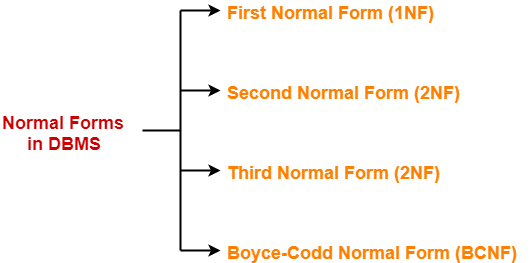Normalization in DBMS-
In DBMS, database normalization is a process of making the database consistent by-
- Reducing the redundancies
- Ensuring the integrity of data through lossless decomposition
Normalization is done through normal forms.
Normal Forms-
The standard normal forms used are-

- First Normal Form (1NF)
- Second Normal Form (2NF)
- Third Normal Form (3NF)
- Boyce-Codd Normal Form (BCNF)
There exists several other normal forms even after BCNF but generally we normalize till BCNF only.
First Normal Form-
A given relation is called in First Normal Form (1NF) if each cell of the table contains only an atomic value.
OR
A given relation is called in First Normal Form (1NF) if the attribute of every tuple is either single valued or a null value.
Example-
The following relation is not in 1NF-
| Student_id | Name | Subjects |
| 100 | Akshay | Computer Networks, Designing |
| 101 | Aman | Database Management System |
| 102 | Anjali | Automata, Compiler Design |
Relation is not in 1NF
However,
- This relation can be brought into 1NF.
- This can be done by rewriting the relation such that each cell of the table contains only one value.
| Student_id | Name | Subjects |
| 100 | Akshay | Computer Networks |
| 100 | Akshay | Designing |
| 101 | Aman | Database Management System |
| 102 | Anjali | Automata |
| 102 | Anjali | Compiler Design |
Relation is in 1NF
This relation is in First Normal Form (1NF).
NOTE-
- By default, every relation is in 1NF.
- This is because formal definition of a relation states that value of all the attributes must be atomic.
Second Normal Form-
A given relation is called in Second Normal Form (2NF) if and only if-
- Relation already exists in 1NF.
- No partial dependency exists in the relation.
Also Read- Functional Dependency in DBMS
Partial Dependency
A partial dependency is a dependency where few attributes of the candidate key determines non-prime attribute(s). OR A partial dependency is a dependency where a portion of the candidate key or incomplete candidate key determines non-prime attribute(s).
In other words, A → B is called a partial dependency if and only if-
If any one condition fails, then it will not be a partial dependency.
NOTE-
|
Also Read- How To Find Candidate Keys?
Example-
Consider a relation- R ( V , W , X , Y , Z ) with functional dependencies-
VW → XY
Y → V
WX → YZ
The possible candidate keys for this relation are-
VW , WX , WY
From here,
- Prime attributes = { V , W , X , Y }
- Non-prime attributes = { Z }
Now, if we observe the given dependencies-
- There is no partial dependency.
- This is because there exists no dependency where incomplete candidate key determines any non-prime attribute.
Thus, we conclude that the given relation is in 2NF.
Third Normal Form-
A given relation is called in Third Normal Form (3NF) if and only if-
- Relation already exists in 2NF.
- No transitive dependency exists for non-prime attributes.
Transitive Dependency
A → B is called a transitive dependency if and only if-
If any one condition fails, then it is not a transitive dependency.
NOTE-
|
OR
A relation is called in Third Normal Form (3NF) if and only if-
Any one condition holds for each non-trivial functional dependency A → B
- A is a super key
- B is a prime attribute
Example-
Consider a relation- R ( A , B , C , D , E ) with functional dependencies-
A → BC
CD → E
B → D
E → A
The possible candidate keys for this relation are-
A , E , CD , BC
From here,
- Prime attributes = { A , B , C , D , E }
- There are no non-prime attributes
Now,
- It is clear that there are no non-prime attributes in the relation.
- In other words, all the attributes of relation are prime attributes.
- Thus, all the attributes on RHS of each functional dependency are prime attributes.
Thus, we conclude that the given relation is in 3NF.
Boyce-Codd Normal Form-
A given relation is called in BCNF if and only if-
- Relation already exists in 3NF.
- For each non-trivial functional dependency A → B, A is a super key of the relation.
Example-
Consider a relation- R ( A , B , C ) with the functional dependencies-
A → B
B → C
C → A
The possible candidate keys for this relation are-
A , B , C
Now, we can observe that RHS of each given functional dependency is a candidate key.
Thus, we conclude that the given relation is in BCNF.
Next Article- Important Points About Normal Forms
Get more notes and other study material of Database Management System (DBMS).
Watch video lectures by visiting our YouTube channel LearnVidFun.

